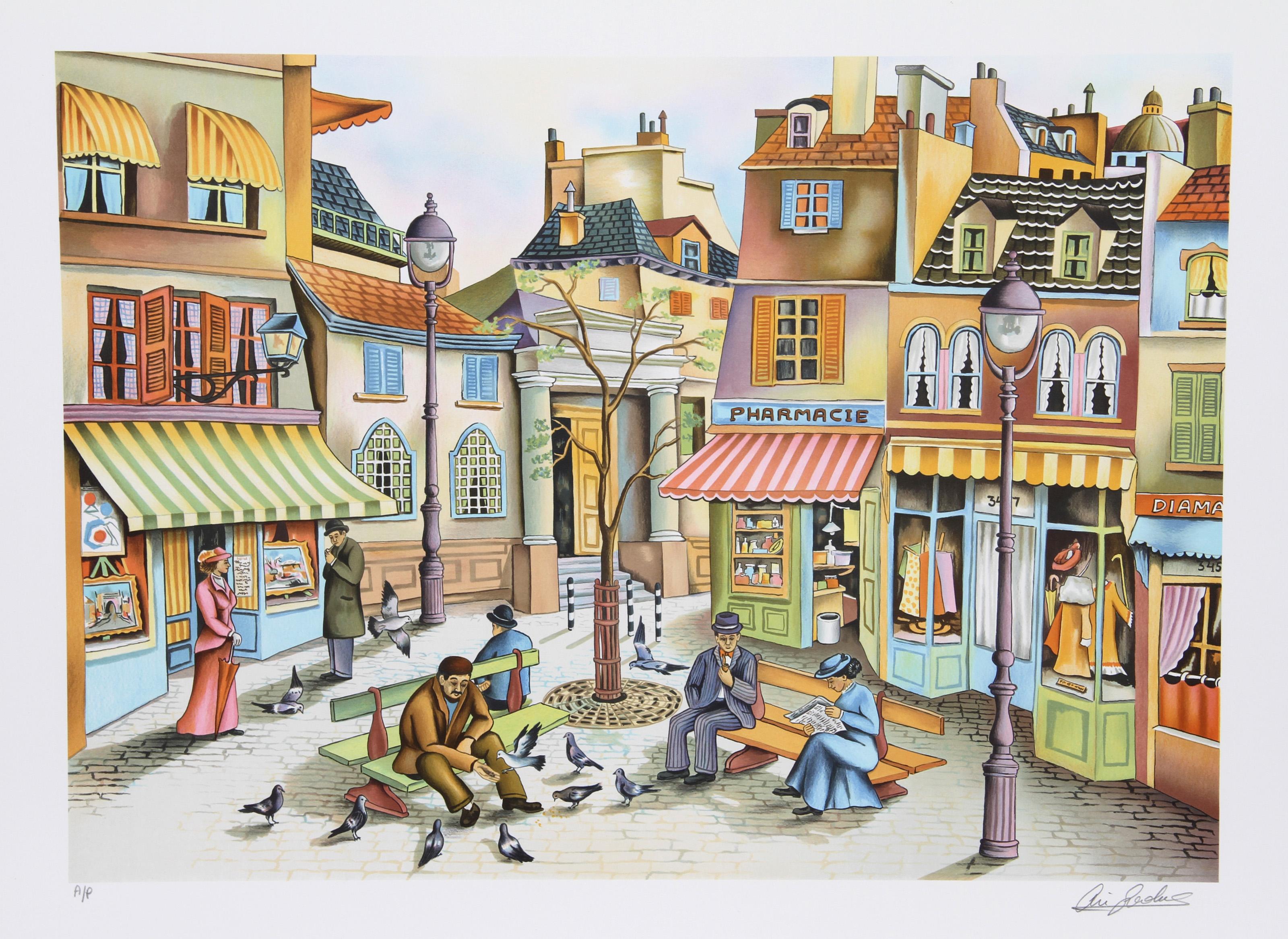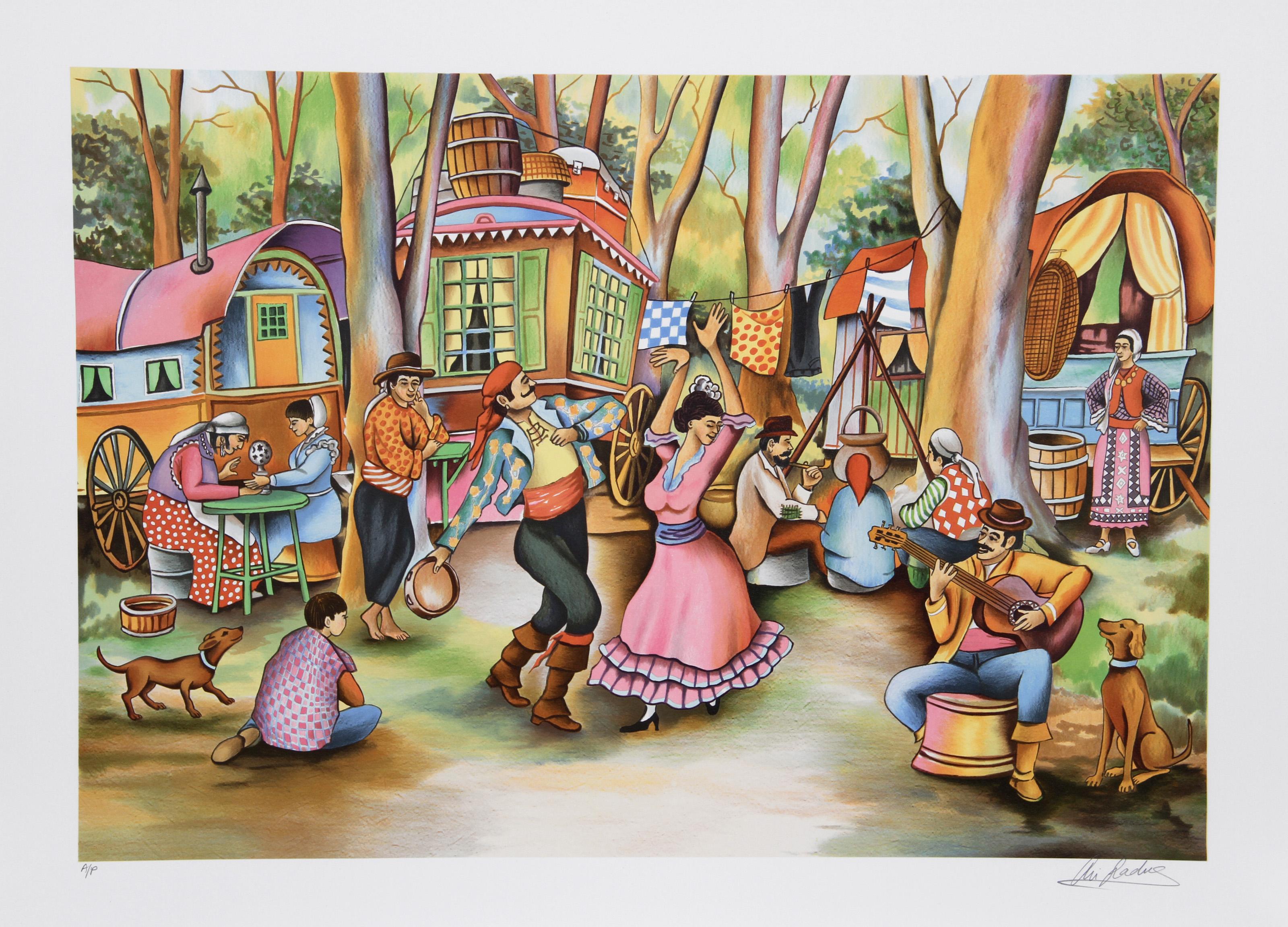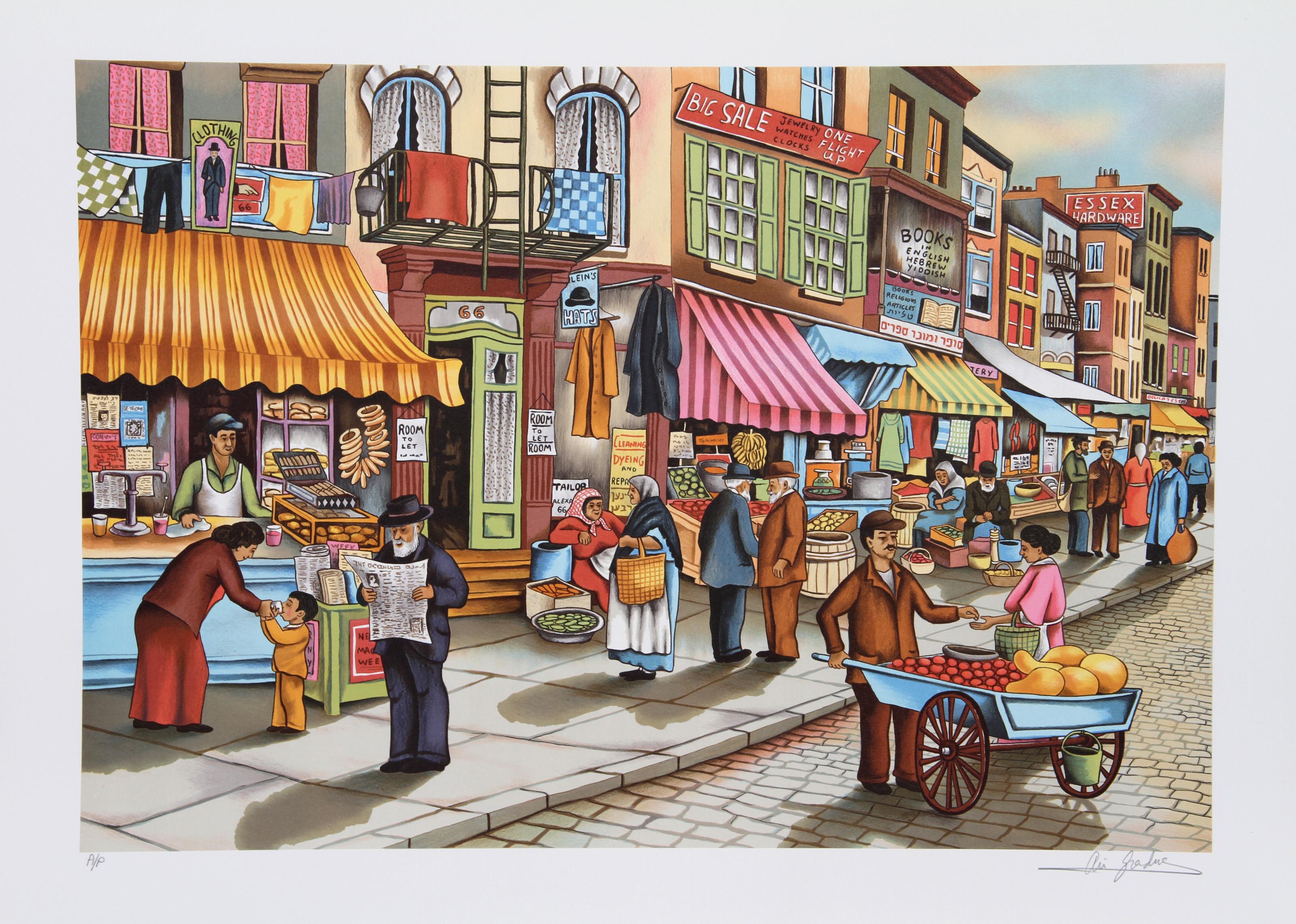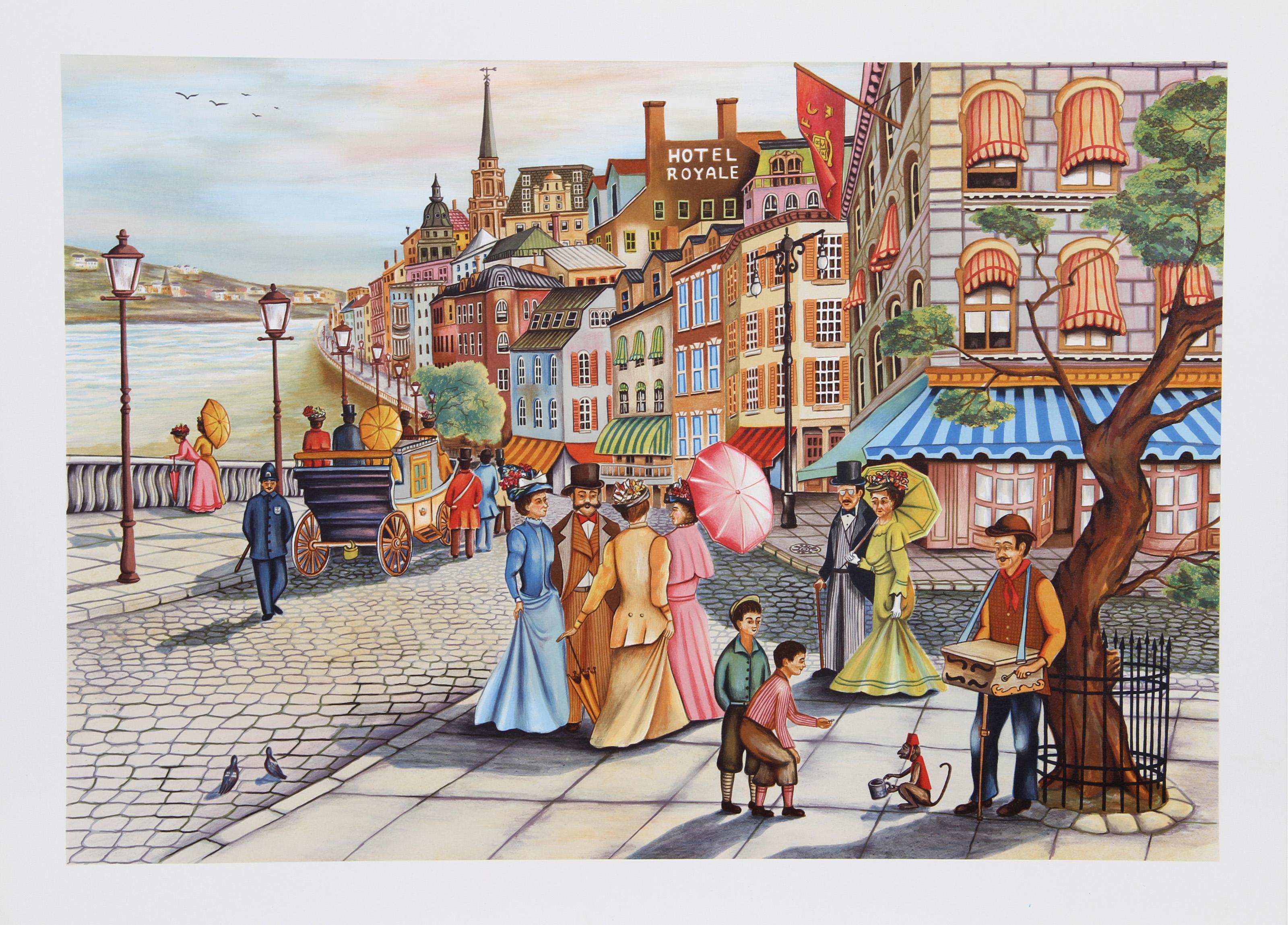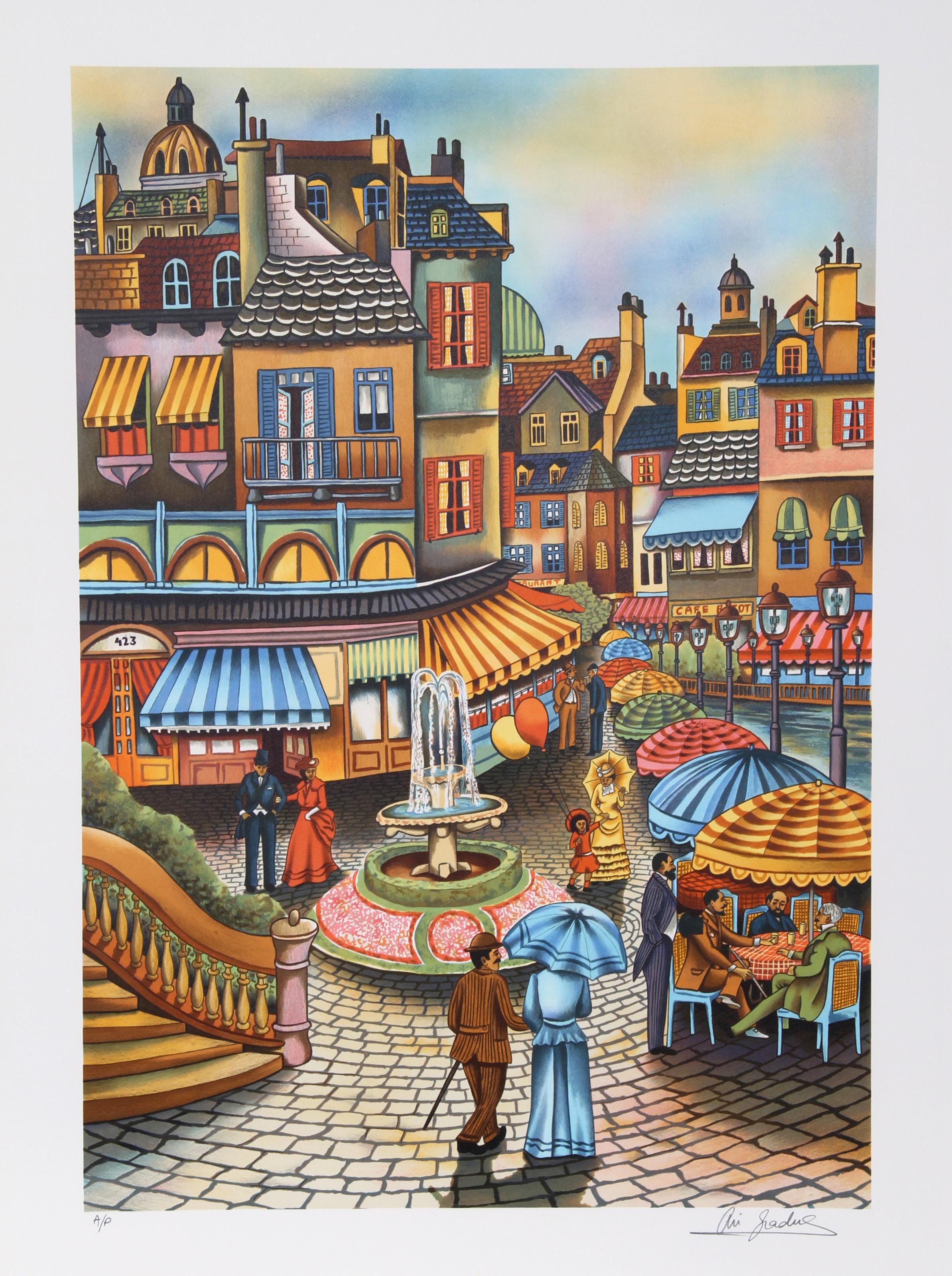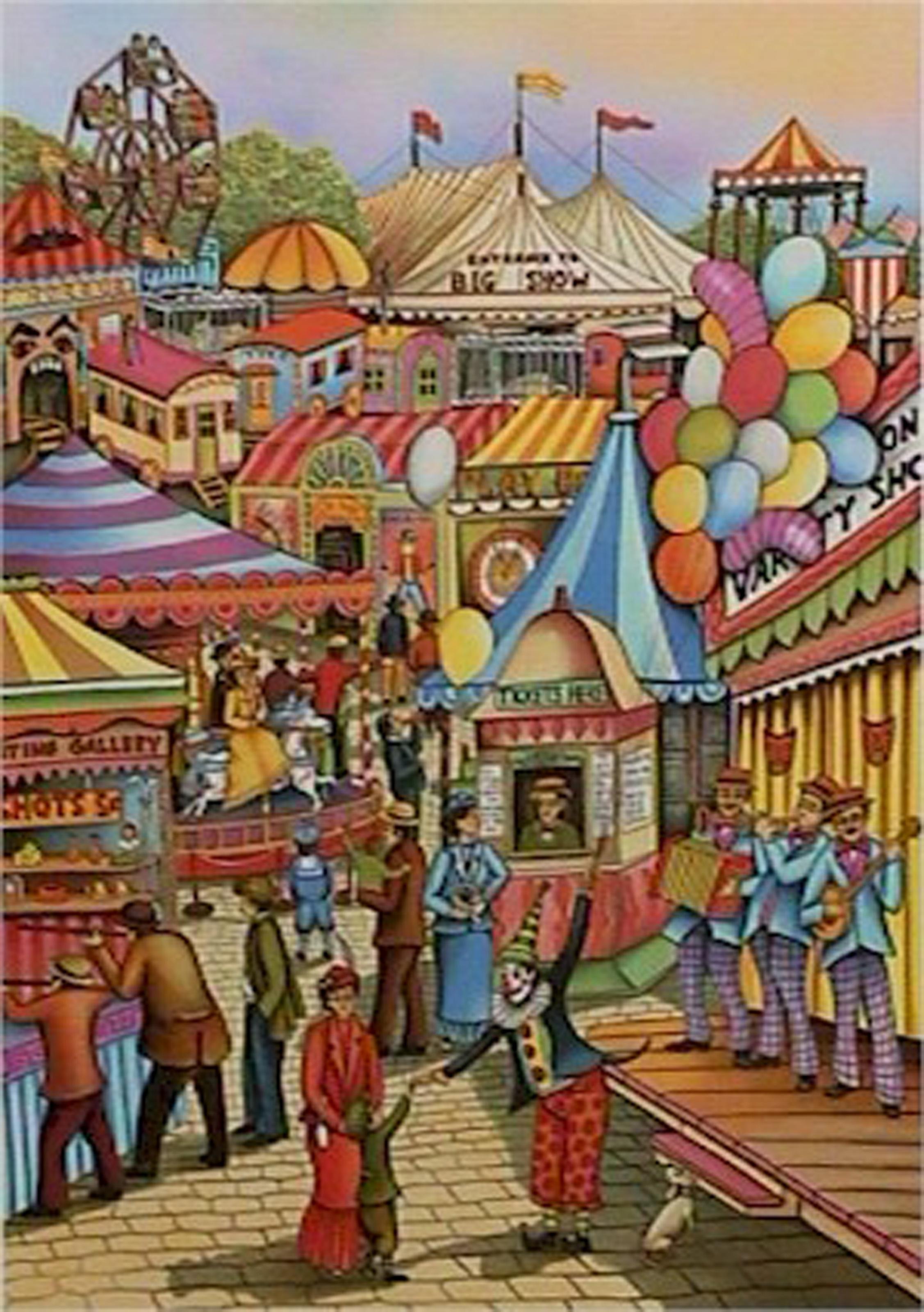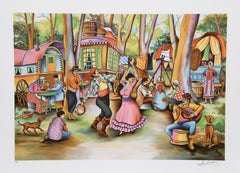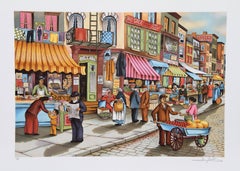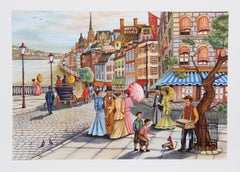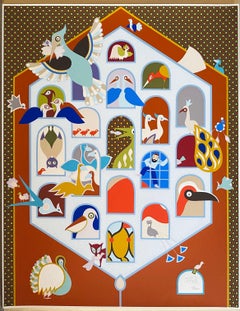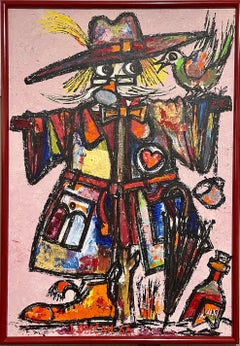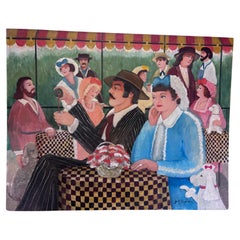Items Similar to The Bird Man, Folk Art Lithograph by Ari Gradus
Want more images or videos?
Request additional images or videos from the seller
1 of 6
Ari GradusThe Bird Man, Folk Art Lithograph by Ari Gradus1980
1980
$400
£308.35
€350.48
CA$569.94
A$620.04
CHF 327.18
MX$7,457.02
NOK 4,127.30
SEK 3,841.11
DKK 2,617.51
About the Item
Ari Gradus, Israeli (1943 - ) - The Bird Man, Year: 1980, Medium: Lithograph, Signed and Numbered in Pencil, Edition: AP, Image Size: 18 x 26 inches, Size: 22 in. x 30 in. (55.88 cm x 76.2 cm), Description: Filled with elements of fantasy blended with reality, this print by Ari Gradus featuring a fair focuses on the eccentric man with a multitude of parrots showing awed spectators his flock.
- Creator:Ari Gradus (1943)
- Creation Year:1980
- Dimensions:Height: 22 in (55.88 cm)Width: 30 in (76.2 cm)
- Medium:
- Movement & Style:
- Period:
- Framing:Framing Options Available
- Condition:
- Gallery Location:Long Island City, NY
- Reference Number:Seller: RO45191stDibs: LU46616001242
About the Seller
4.9
Platinum Seller
Premium sellers with a 4.7+ rating and 24-hour response times
Established in 1979
1stDibs seller since 2014
3,190 sales on 1stDibs
Typical response time: 1 hour
- ShippingRetrieving quote...Shipping from: Long Island City, NY
- Return Policy
More From This Seller
View AllPigeon Feeder, Folk Art Lithograph by Ari Gradus
By Ari Gradus
Located in Long Island City, NY
Ari Gradus, Israeli (1943 - ) - Pigeon Feeder, Year: 1980, Medium: Lithograph, Signed and Numbered in Pencil, Edition: AP, Image Size: 26 x 18 inches, ...
Category
1980s Folk Art Landscape Prints
Materials
Lithograph
Gypsy Fever, Folk Art Lithograph by Ari Gradus
By Ari Gradus
Located in Long Island City, NY
Ari Gradus, Israeli (1943 - ) - Gypsy Fever, Year: 1980, Medium: Lithograph, Signed and Numbered in Pencil, Edition: AP, Image Size: 18 x 26 inches, Siz...
Category
1980s Folk Art Landscape Prints
Materials
Lithograph
Old New York, Folk Art Lithograph by Ari Gradus
By Ari Gradus
Located in Long Island City, NY
Ari Gradus, Israeli (1943 - ) - Old New York, Year: 1980, Medium: Lithograph, signed in pencil, Edition: AP, Image Size: 18 x 26 inches, Size: 22 in. x 30 in. (55.88 cm x 76.2 c...
Category
1980s Folk Art Landscape Prints
Materials
Lithograph
Afternoon Stroll, Folk Art Lithograph by Ari Gradus
By Ari Gradus
Located in Long Island City, NY
Ari Gradus, Israeli (1943 - ) - Afternoon Stroll, Year: 1980, Medium: Lithograph, Signed and Numbered in Pencil, Edition: AP, Image Size: 18 x 26 inches, Size: 21.5 in. x 29 in....
Category
1980s Folk Art Landscape Prints
Materials
Lithograph
The Fountain's Square, Folk Art Lithograph by Ari Gradus
By Ari Gradus
Located in Long Island City, NY
Ari Gradus, Israeli (1943 - ) - The Fountain's Square, Year: 1980, Medium: Lithograph, Signed and Numbered in Pencil, Edition: AP, Image Size: 26 x 18 inches, Size: 30 in. x 22...
Category
1980s Folk Art Landscape Prints
Materials
Lithograph
At the Fair, Folk Art Lithograph by Ari Gradus
By Ari Gradus
Located in Long Island City, NY
Ari Gradus, Israeli (1943 - ) - At the Fair, Year: 1980, Medium: Lithograph, signed and numbered in pencil, Edition: AP, Size: 30 x 22 in. (76.2 x 55.88 cm), Description: Bust...
Category
1980s Folk Art Landscape Prints
Materials
Lithograph
You May Also Like
Israeli Naive Folk Art Birdhouse Silkscreen Lithograph David Sharir Birds
By David Sharir
Located in Surfside, FL
David Sharir was born in 1938 in Tel Aviv, Israel and currently resides there.
David Sharir, the son of Russian immigrants, was born in Israel. Beginning his study of art in Tel Aviv...
Category
20th Century Folk Art Figurative Prints
Materials
Screen
People of the Village
Located in San Francisco, CA
This artwork titled "People of the Village" c.1980, is an oil painting on canvas by Hungarian artist Anton Kowalski, b.1926. It is signed at the lower right corner by the artist. The canvas size is 21 x 24 inches, framed size is 26.5 x 30.5 inches. Framed in original dark wood and green frame, with fabric liner. It is in excellent condition.
About the artist:
The artist was born in Sopron in Hungary in 1926. He was a student of the Academy of Budapest and during the uprising in 1956 against Communism he escaped from Hungary to Vienna where he now lives and works.
He has become internationally known for his (typically East European style) “Naive” paintings depicting Village life in the four seasons in glorious color. Children especially like his works as each one tells a story.
He has exhibited in many Galleries throughout Europe, particularly in Munich, Vienna, Tokyo, and Harrods in London. His work has been on permanent exhibition at the Stewart Gallery...
Category
Mid-20th Century Folk Art Figurative Paintings
Materials
Oil
Large Naive European Folk Art Oil Painting Lazar Obican French Scarecrow Clown
Located in Surfside, FL
Lazar Obican 1944-2004
Genre: Other
Subject: People
Medium: Oil
Surface: Canvas
Dimensions: 35" x 16.5
Dimensions w/Frame: 35.5" x 17.25
An impasto composition that depicts a colorful scarecrow clown with a bird perched on his shoulder with a bottle of French Vin (wine)
Artist signature L OBICAN to bottom and dated 1968. Title to verso.
Work Size: 36 x 25 in. Framed 37.5 x 26 x 1 in
The artist Lazar Obican iconic style is child-like yet masterfully adult; a style that tells a story with sociological overtones. His funny little people are always colorful, full of spirit, living with music and birds to bring them happiness.
Lazar Obican artist, painter, sculpture and mosaic ceramic artisan was born in Cannes, France, to his Yugoslavian family. He finished his training, imbued with the spirit of his native country, the people, their legends, and their philosophy. It has been said that his work has a "timeless quality" and a naive, folk art, outsider art brut quality, child-like primitive style. Obican is identified with his style the world over, a style that is simple yet sophisticated; child-like yet masterfully adult; a style that tells a story with psychological, philosophical or sociological overtones. His funny little people are always colorful, full of spirit, living with music and birds to bring them happiness. Best known for his depictions of folklore and traditional costumes rendered in a playful, childlike style and for his happy Jewish wedding scenes. He often used bright colors and black outlines in his renderings of figures and animals, giving his work an illustration-like quality. Thematically, the artist’s work is similar to Marc Chagall and Jean Dubuffet for its dreamlike images and so-called naïve style of painting. Over the course of his career, the artist maintained a studio in Boca Raton, Florida and Dubrovnik, Croatia—part of former Yugoslavia— where he developed an interest in Eastern Europe’s Jewish culture. Many of his mature works depict Jewish traditions and ceremonies, including traditional Jewish weddings, the dancing of the Hora, and traditional music. There is a display of his works in his former Dubrovnik studio.
His style is a unique conglomerate of tradition, history, legends, heroes, old customs and folklore. It is a self-standing style, recognizable, cheerful, whimsical and a happy creation. Naïve art is any form of visual art that is created by a person who lacks the formal education and training that a professional artist undergoes (in anatomy, art history, technique, perspective, ways of seeing). Unlike folk art, naïve art does not necessarily evince a distinct cultural context or tradition. Naïve art is recognized, and often imitated, for its childlike simplicity and frankness. Paintings of this kind typically have a flat rendering style with a rudimentary expression of perspective.
One particularly influential painter of "naïve art" was Henri Rousseau (1844–1910), a French Post-Impressionist who was discovered by Pablo Picasso. Naïve art is often seen as outsider art that is by someone without formal (or little) training or degree. While this was true before the twentieth century, there are now academies for naïve art. Naïve art is now a fully recognized art genre, represented in art galleries worldwide.
Museums devoted to naïve art now exist in Kecskemét, Hungary; Riga, Latvia; Jaen, Spain; Rio de Janeiro, Brasil; Vicq France and Paris. "Primitive art" is another term often applied to art by those without formal training, but is historically more often applied to work from certain cultures that have been judged socially or technologically "primitive" by Western academia, such as Native American, sub saharan African or Pacific Island art (see Tribal art). This is distinguished from the self-conscious, "primitive" inspired movement primitivism. Another term related to (but not completely synonymous with) naïve art is folk art. There also exist the terms "naïvism" and "primitivism" which are usually applied to professional painters working in the style of naïve art (like Paul Gauguin, Mikhail Larionov, Paul Klee).
At all events, naive art can be regarded as having occupied an "official" position in the annals of twentieth-century art since - at the very latest - the publication of the Der Blaue Reiter, an almanac in 1912. Wassily Kandinsky and Franz Marc, who brought out the almanac, presented 6 reproductions of paintings by le Douanier' Rousseau (Henri Rousseau), comparing them with other pictorial examples. However, most experts agree that the year that naive art was "discovered" was 1885, when the painter Paul Signac became aware of the talents of Henri Rousseau and set about organizing exhibitions of his work in a number of prestigious galleries. The Earth Group (Grupa Zemlja) were Croatian artists, architects and intellectuals active in Zagreb from 1929 to 1935. The group included the painters Krsto Hegedušić, Edo Kovačević, Omer Mujadžić, Kamilo Ružička, Ivan Tabaković, and Oton Postružnik, the sculptors Antun Augustinčić, Frano Kršinić, and the architect Drago Ibler. A term applied to Yugoslav (Croatian) naive painters working in or around the village of Hlebine, near the Hungarian border, from about 1930. Some of the best known naive artists are Dragan Gaži, Ivan Generalić, Josip Generalić, Krsto Hegedušić, Mijo Kovačić, Ivan Lacković-Croata, Franjo Mraz, Ivan Večenaj and Mirko Virius. Camille Bombois (1883–1970) Ferdinand Cheval, known as 'le facteur Cheval' (1836–1924) Henry Darger (1892–1973) L. S. Lowry (1887–1976) Grandma Moses, Anna Mary Robertson...
Category
1960s Folk Art Figurative Paintings
Materials
Canvas, Oil
A Votre Sante Cafe Painting Outsider Folk Artist Gloria Laposka
Located in South Burlington, VT
A Votre Sante Cafe Gathering With Pet Dogs - Vibrant Colored Hand Painting
An oil painting on canvas panel by Self Taught Outsider Surrealist Folk Artist Gloria Antoinette Lapo...
Category
Late 20th Century American Folk Art Outsider and Self Taught Art
Materials
Canvas
$1,200 Sale Price
20% Off
Original Graphic Hungarian Illustration Art Emma Heinzelmann Children's Book Art
Located in Surfside, FL
Original vintage gouache painting on poster board by Emma Heinzelmann (Hungarian, born 1930). Hungarian Peasant art, children fairytale themes, in psychedelic pop colors of the era. ...
Category
Mid-20th Century Folk Art Figurative Paintings
Materials
Gouache
Carnaval Lithograph by Maria Elena Veiira Da Silva, 1978
Located in AMSTERDAM, NL
This beautiful lithograph by the Portuguese artist Maria Helena Vieira da Silva (1908–1992), explores spatial dynamics through a thoughtful arrangement of cubes, cones, and circles. ...
Category
20th Century Paintings
Materials
Paper
